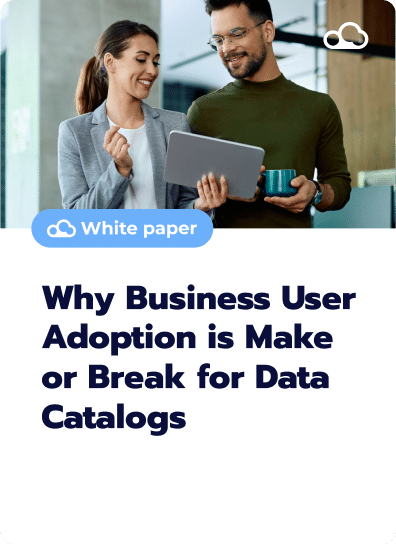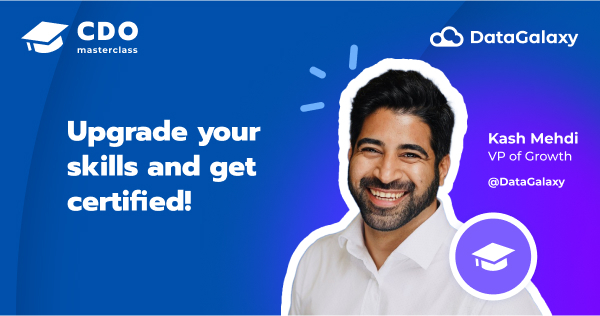Now more than ever with the popularization of generative AI tools, data risk involves the entire organization. However, risk isn’t necessarily about identifying vulnerabilities, it’s more about the impact of vulnerabilities on the whole organization.
This blog post explores strategies for effectively mitigating and managing data risk, ensuring success in a rapidly evolving landscape.
This information was originally shared by Della Shea during Season 5 of DataGalaxy’s CDO Masterclass - An interactive, three-day online course giving data professionals the unique opportunity to learn from the world’s top brands leading data-driven transformation.
Join us next season of CDO Masterclass for more insights like this!
Data risk encompasses the potential for loss, damage, or misuse of data. It involves both internal and external threats, including cyber attacks, data breaches, and regulatory noncompliance.
Effective data risk management ensures that sensitive information is protected against unauthorized access, data quality is maintained, and systems are resilient to disruptions. By implementing robust security protocols, regular audits, and backup strategies, data warehouse managers can safeguard their data assets, ensure regulatory compliance, and maintain the trust of stakeholders.
This proactive approach helps prevent costly incidents and supports the reliable operation of data-driven decision-making processes.
Data risk is essential for Chief Data Officers
- Innovation & competitive advantage: Understanding and mitigating data risks helps CDOs align data strategies with broader business objectives, ensuring that data initiatives support and enhance the organization's overall performance and resilience in a dynamic market.
- Business performance: By effectively managing data risks, CDOs can foster a culture of trust and reliability, enabling the organization to leverage data confidently to achieve business goals.
- Strategic decision-making: Strategic decisions rely heavily on accurate, secure, and compliant data to drive business growth, innovation, and competitive advantage.
- Cybersecurity & resiliency: CDOs must ensure that data is secure, accurate, and compliant with regulatory requirements to avoid potential financial losses, reputational damage, and legal penalties.
- Privacy & data protection: By identifying vulnerabilities and implementing robust security measures, CDOs can prevent unauthorized access, data breaches, and misuse of personal information.
- Stakeholder trust: Stakeholders, including customers, investors, partners, and regulators, place immense trust in the organization's ability to protect sensitive information and ensure data accuracy. By proactively addressing data risks, CDOs can build and maintain strong relationships with stakeholders, enhancing their confidence in the organization's data handling capabilities.
- Compliance & regulatory risk: As guardians of an organization's data assets, CDOs must navigate an increasingly complex landscape of data privacy regulations and standards, such as GDPR and CCPA, which impose stringent requirements on how personal data is handled.
- Enabling safe & responsible use of AI: AI models rely heavily on large datasets for training and decision-making; if these datasets are compromised, biased, or non-compliant with data protection regulations, the AI outcomes can be flawed, discriminatory, or harmful.
Effective data risk management helps CDOs safeguard against these issues by implementing robust data governance frameworks, ensuring data quality, and maintaining transparency in data usage.
CDO Masterclass
Upgrade your data leadership in just 3 days
Join DataGalaxy’s CDO Masterclass to gain actionable strategies, learn from global leaders like Airbus and LVMH, and earn an industry-recognized certification. This immersive program equips data professionals to drive impactful, data-powered transformations.
Enterprise risk management
There are several types of enterprise risk management, including:
- Principle: Integrate, structured and comprehensive, customizable, best available information, risk culture and human factor, continuous improvement
- Framework: Leadership commitment, oversight, design integration, implementation and execution, evaluation and improvement
- Process: Communication and consultation, scope and context and criteria, risk assessment and risk treatment, monitoring and review, recording and reporting
Establishing robust controls and governance frameworks is critical to mitigate data risk. An organization must establish appropriate risk tolerance and be able to identify risks as they arise.
- Risk assessments: Conducting comprehensive risk assessments is essential to identify vulnerabilities within the data ecosystem. This involves evaluating and looking at data risks across an organization's ecosystem across multiple dimensions.
- Implementing controls: Establishing robust controls and governance frameworks is critical to mitigate data risk. It is important that an organization establishes appropriate risk tolerance and appetite for certain risks and vulnerabilities. This is important to guide investment decisions.
- Preparing a risk response plan: Developing a comprehensive risk response plan is imperative to minimize the impact of potential risk events such as a data breach. This involves incident response protocols, communication strategies, and collaboration with relevant stakeholders.
- Measuring & monitoring performance: Establishing key performance indicators (KPIs) and metrics to measure the effectiveness of data risk management strategies is crucial. This enables continuous improvement and demonstrates the value of risk management efforts.
Optimizing risk management for future success
- Cross-organization collaboration: As organizations increasingly collaborate to drive innovation and efficiency, they must also collectively address and manage potential risks that can impact the entire network. This requires establishing standardized risk management frameworks, sharing best practices, and ensuring that all parties are aligned on risk tolerance levels and mitigation strategies.
By working together, organizations can identify vulnerabilities more effectively, pool resources to implement robust security measures and respond to threats with greater agility.
This collaborative approach not only enhances the overall resilience of each organization but also builds stronger, trust-based relationships that can lead to more successful and sustainable partnerships. By prioritizing joint risk management, organizations can better navigate the complexities of the modern business landscape and achieve long-term success.
- Define policies & processes: Establishing well-defined policies provides a structured approach to identifying, assessing, and mitigating risks, ensuring that all employees understand their roles and responsibilities in maintaining data security and integrity. These policies should encompass best practices for data handling, compliance with regulatory requirements, incident response, and continuous monitoring.
Regularly updating and testing these policies and processes ensures they remain effective and relevant. By embedding risk management into the organizational fabric through clear policies and robust processes, companies can proactively address potential threats, minimize disruptions, and secure a competitive edge in a rapidly changing landscape.
This strategic approach not only protects the organization but also instills confidence among stakeholders, paving the way for sustainable growth and future success.
- Continuous improvement mindset: By fostering a culture of continuous improvement, organizations can proactively identify and address weaknesses in their risk management processes, implement innovative solutions, and enhance their resilience against potential disruptions.
A continuous improvement mindset not only strengthens the organization’s ability to manage risks effectively but also promotes a proactive, agile approach that is essential for navigating the complexities of the modern business environment. Ultimately, this commitment to perpetual enhancement ensures that risk management strategies remain robust, dynamic, and aligned with the organization’s long-term objectives, paving the way for sustained success.
In conclusion, mastering data risk is imperative for organizations aiming to thrive in today’s data-driven world. By embracing cross-organization collaboration, defining clear policies and processes, and maintaining a continuous improvement mindset, organizations can navigate the complexities of the modern business environment with agility and confidence.
These strategies not only safeguard against potential threats but also promote sustainable growth, resilience, and long-term success in an ever-evolving landscape.
If you enjoyed this content, join us in the next season of DataGalaxy’s CDO Masterclass to further explore these topics and equip yourself with the knowledge to lead data-driven transformation.
Fueling smarter decisions for
200+ industry powerhouses.










